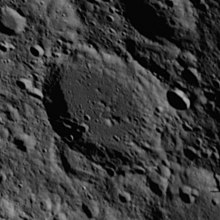Ostwald (crater)
Ostwald is a lunar impact crater on the far side of the Moon. It lies just to the east of the crater Guyot, and near the northern border of Ibn Firnas. Recht lies along its eastern rim.
 Apollo 16 mapping camera image (north is in upper right) | |
| Coordinates | 10.4°N 121.9°E |
|---|---|
| Diameter | 104 km |
| Depth | 3.9 km |
| Colongitude | 239° at sunrise |
| Eponym | Wilhelm Ostwald |

This is a worn and eroded crater formation with an irregular rim and inner wall due to multiple small impacts. A brief crater chain forms a cleft in the western inner face. The interior is somewhat more level, but is pock-marked by a multitude of tiny craterlets. There are some low central ridges to the south and northeast of the midpoint.
Naming
The crater is named after German chemist and Nobel laureate Wilhelm Ostwald. Prior to naming in 1970 by the IAU,[1] this crater was known as Crater 212.[2]
Satellite craters
By convention these features are identified on lunar maps by placing the letter on the side of the crater midpoint that is closest to Ostwald.
| Ostwald | Latitude | Longitude | Diameter |
|---|---|---|---|
| Y | 13.6° N | 121.0° E | 24 km |
References
- Ostwald, Gazetteer of Planetary Nomenclature, International Astronomical Union (IAU) Working Group for Planetary System Nomenclature (WGPSN)
- Lunar Farside Chart (LFC-1A)
- Andersson, L. E.; Whitaker, E. A. (1982). NASA Catalogue of Lunar Nomenclature. NASA RP-1097.CS1 maint: ref=harv (link)
- Bussey, B.; Spudis, P. (2004). The Clementine Atlas of the Moon. New York: Cambridge University Press. ISBN 978-0-521-81528-4.CS1 maint: ref=harv (link)
- Cocks, Elijah E.; Cocks, Josiah C. (1995). Who's Who on the Moon: A Biographical Dictionary of Lunar Nomenclature. Tudor Publishers. ISBN 978-0-936389-27-1.CS1 maint: ref=harv (link)
- McDowell, Jonathan (July 15, 2007). "Lunar Nomenclature". Jonathan's Space Report. Retrieved 2007-10-24.CS1 maint: ref=harv (link)
- Menzel, D. H.; Minnaert, M.; Levin, B.; Dollfus, A.; Bell, B. (1971). "Report on Lunar Nomenclature by the Working Group of Commission 17 of the IAU". Space Science Reviews. 12 (2): 136–186. Bibcode:1971SSRv...12..136M. doi:10.1007/BF00171763.CS1 maint: ref=harv (link)
- Moore, Patrick (2001). On the Moon. Sterling Publishing Co. ISBN 978-0-304-35469-6.CS1 maint: ref=harv (link)
- Price, Fred W. (1988). The Moon Observer's Handbook. Cambridge University Press. ISBN 978-0-521-33500-3.CS1 maint: ref=harv (link)
- Rükl, Antonín (1990). Atlas of the Moon. Kalmbach Books. ISBN 978-0-913135-17-4.CS1 maint: ref=harv (link)
- Webb, Rev. T. W. (1962). Celestial Objects for Common Telescopes (6th revised ed.). Dover. ISBN 978-0-486-20917-3.CS1 maint: ref=harv (link)
- Whitaker, Ewen A. (1999). Mapping and Naming the Moon. Cambridge University Press. ISBN 978-0-521-62248-6.CS1 maint: ref=harv (link)
- Wlasuk, Peter T. (2000). Observing the Moon. Springer. ISBN 978-1-85233-193-1.CS1 maint: ref=harv (link)
External links
| Wikimedia Commons has media related to Ostwald (lunar crater). |